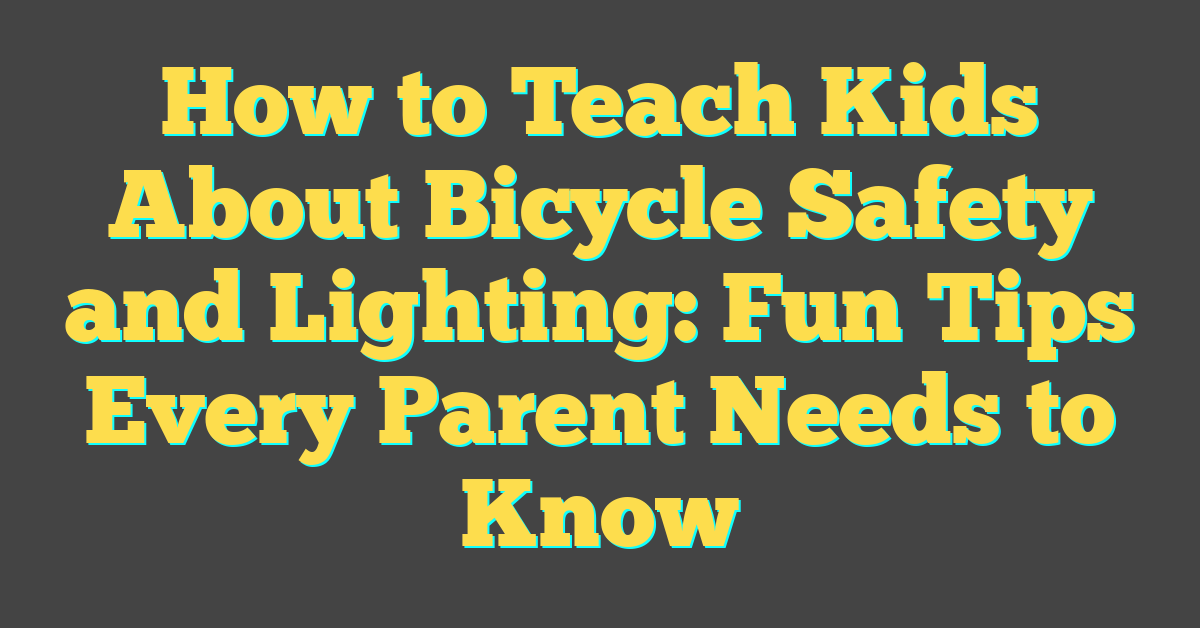Teaching kids about bicycle safety and proper lighting is one of the most important lessons we can share. Riding a bike is such a fun and freeing experience, but it also comes with responsibilities. Kids need to understand how to stay safe while enjoying their adventures, especially when it comes to being visible and cautious on the road.

I’ve found that making safety lessons engaging and hands-on works wonders. From choosing the right gear to understanding traffic rules and the importance of lights, there are so many simple ways to turn these lessons into lasting habits. It’s not just about rules—it’s about giving them the confidence to ride safely and responsibly.
Why Bicycle Safety And Lighting Matter For Kids
Keeping kids safe on bikes combines fun riding habits with essential safety measures. Proper safety practices reduce risks of injuries while building their confidence on the road. Teaching the importance of visibility ensures they’re seen by others, especially in low-light conditions.
Lighting plays a key role in every ride, whether it’s a sunny day or a dim evening. Lights not only improve visibility but also signal a child’s presence to others. For example, front white lights illuminate paths, while rear red lights alert drivers and pedestrians. Using reflective tape on helmets or frames adds even more visibility during dawn or dusk.
Understanding how lighting integrates with traffic behavior prepares kids for real-world situations. In my experience, educating children on choosing durable, bright, and easy-to-fit lights makes a difference. Prioritizing lightweight and rechargeable options ensures maintenance doesn’t overwhelm them or their parents.
Essential Bicycle Safety Tips For Kids
Teaching kids how to stay safe while riding starts with basic yet crucial practices. Proper gear, bicycle maintenance, and understanding traffic rules form the foundation of safe cycling habits.
Wearing A Helmet Properly
A well-fitted helmet is non-negotiable for any rider, particularly kids. I always emphasize checking that the helmet sits snugly atop the head, covering the forehead without tilting back. Straps should form a “V” under the ears and fasten securely under the chin while allowing enough room for two fingers to fit between the strap and the skin. For added safety, I recommend helmets with a bright color or reflective elements to enhance visibility.
Importance Of Maintaining The Bike
A well-maintained bike keeps kids safe by reducing mechanical risks. I inspect brakes, tires, and chains frequently, teaching kids to do basic checks themselves before every ride. Brake pads should show no excessive wear, tires must be inflated to the proper pressure (commonly printed on the sidewall), and chains need to stay free of dirt and excess slack. A quick 5-minute check can prevent avoidable breakdowns, ensuring a smooth and safe experience.
Rules Of The Road
Kids riding in public spaces need to follow standard traffic rules to stay out of harm’s way. I teach basics like stopping at signs, using hand signals for turns, and riding in the same direction as traffic. For added visibility during evening rides, front white lights and rear red lights are essential. I also stress the importance of staying predictable—a sudden swerve into traffic can cause serious accidents. Reinforcing these habits early ensures kids aren’t just safe but also confident riders.
Teaching Kids About Bicycle Lighting
Helping kids understand bicycle lighting is crucial for their safety during early morning or evening rides. As someone passionate about bikes and lighting, I’ve seen how the right lights and practices make a huge difference.
Types Of Bicycle Lights And Their Uses
Bike lights come in two main types: visibility lights and headlights. Visibility lights, like flashing front white and rear red LEDs, ensure other road users see your child. Headlights, on the other hand, illuminate the road ahead in darker conditions. For example, I recommend adjustable LED lights with at least 100 lumens for urban areas and over 200 lumens for trails. Look for lightweight and rechargeable lights to make them easier for kids to handle.
Importance Of Reflectors And Bright Clothing
Reflectors complement lighting by improving visibility from different angles. Bikes typically include reflectors on pedals, wheels, and seats, but I suggest adding extra reflective stickers for enhanced visibility. Bright clothing, like neon vests or jackets, keeps kids noticeable during daytime and low-light settings. When paired with reflectors and lights, these efforts significantly reduce risks.
Demonstrating Proper Lighting Practices
Show kids exactly how to use and maintain their lights. I advise explaining when to turn on lights, testing brightness settings, and checking battery levels before each ride. Practice attaching and detaching lights, ensuring they’re secure. I find that kids enjoy the hands-on aspect, whether adjusting a helmet-mounted light or snapping a rear light onto the seat post.
Engaging Activities To Teach Bicycle Safety
Hands-on activities make safety lessons memorable and fun. By practicing drills and creating engaging scenarios, I help kids internalize key bike safety principles, including the importance of proper lighting.
Practicing Safety Drills
Safety drills instill essential habits through repetition. I set up controlled areas like driveways or empty parking lots to teach basics without distractions. Kids practice braking efficiently by stopping within marked zones, which improves reaction times. I also teach them to look both ways and signal their turns using clear hand gestures while navigating small obstacle courses.
« The Role of Lighting in Bicycle Advocacy and Urban Design: How It Transforms City Safety
Bicycle Lighting for Extreme Conditions: Deserts, Mountains, etc. – Top Picks and Expert Tips »
For lighting, I simulate dusk or low-light conditions by dimming the area slightly. Kids take turns turning on their bike lights, ensuring the front white light and rear red light are visible from a distance. Reflectors also play a role as I guide them in positioning their bikes to see how light bounces off.
Creating Fun Scenarios For Learning
Immersive scenarios turn safety lessons into games. I set up pretend intersections using chalk and traffic cones, assigning road signs for kids to follow. They role-play as pedestrians, drivers, and cyclists, practicing how to navigate traffic safely.
To highlight lighting, I introduce “hide-and-seek visibility”. Each bike gets lights and reflective gear, and kids find others by spotting their lights or reflective clothing in dim settings. This helps them understand how visibility can keep them safe. I also include challenges like “light checks”, where they inspect batteries and brightness before “riding” through the scenario.
Tips For Parents To Reinforce Bicycle Safety
Teaching bicycle safety starts with consistent reinforcement at home. From my experience as both a bike enthusiast and lighting expert, here are strategies to help parents instill safe biking habits in their kids.
- Model Safe Behavior
I always prioritize leading by example. Parents riding their bikes responsibly—wearing helmets, using lights, and following traffic rules—create visual lessons for kids to emulate. Children notice these habits, and seeing their parents ride safely encourages them to do the same.
- Highlight the Role of Lighting
Good bike lighting is indispensable. I recommend sitting with your kids to show them how front white lights and rear red lights make riders visible, especially in dim conditions. Teach them to check their light brightness and battery levels before every ride. Use a simple practice route in the driveway or neighborhood to demonstrate how effective these lights are in keeping them safe.
- Make Safety Gear Familiar
Getting kids comfortable with helmets and other safety gear makes them more likely to use them often. Help them properly adjust helmet straps and explain the importance of snug fits. If they see you donning your gear every ride, they’ll feel it’s a natural part of biking.
- Create Pre-Ride Checklists
I know from years of riding that routine checks prevent surprises on the road. Guide kids to verify their bike’s brakes, tires, chain, and lighting systems before riding. Turn this into a game by timing them to see how fast they can complete the checklist while ensuring thoroughness. It’s engaging and builds responsibility.
- Use Hands-On Training
Interactive demonstrations stick better than verbal instructions. I suggest setting up obstacle courses or simulated traffic scenarios in a safe space. Include elements like braking drills and hand signal exercises. For lighting practice, ride with your kids at dusk to illustrate why lights and reflectors matter.
- Incorporate Fun Challenges
Make learning about lighting and safety exciting. For example, play “spot the lights” at night, where kids identify active lighting setups from a distance. This sharpens their observational skills while underscoring lighting’s value in visibility.
- Reward Positive Habits
Recognizing efforts works wonders. Celebrate when kids consistently use their lights, follow rules, or complete their checklists. Small rewards, like stickers for their helmets or a new bell, reinforce their commitment to safe biking.
Conclusion
Teaching kids about bicycle safety and lighting is one of the most valuable lessons we can give them. It’s not just about following rules; it’s about empowering them to feel confident and secure while enjoying their rides. By combining hands-on practice with engaging activities, we make learning both effective and fun.
As parents and caregivers, our involvement plays a huge role in shaping these habits. When we model safe behavior and encourage responsibility, we’re setting our kids up for a lifetime of safe biking adventures. Let’s keep building those skills together and make every ride a safe one!




